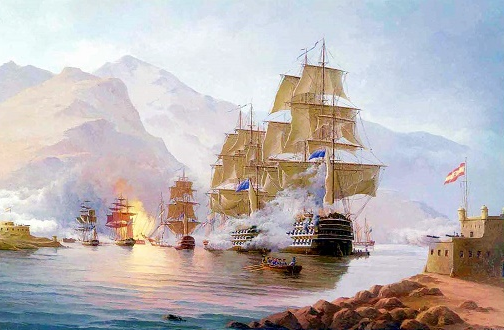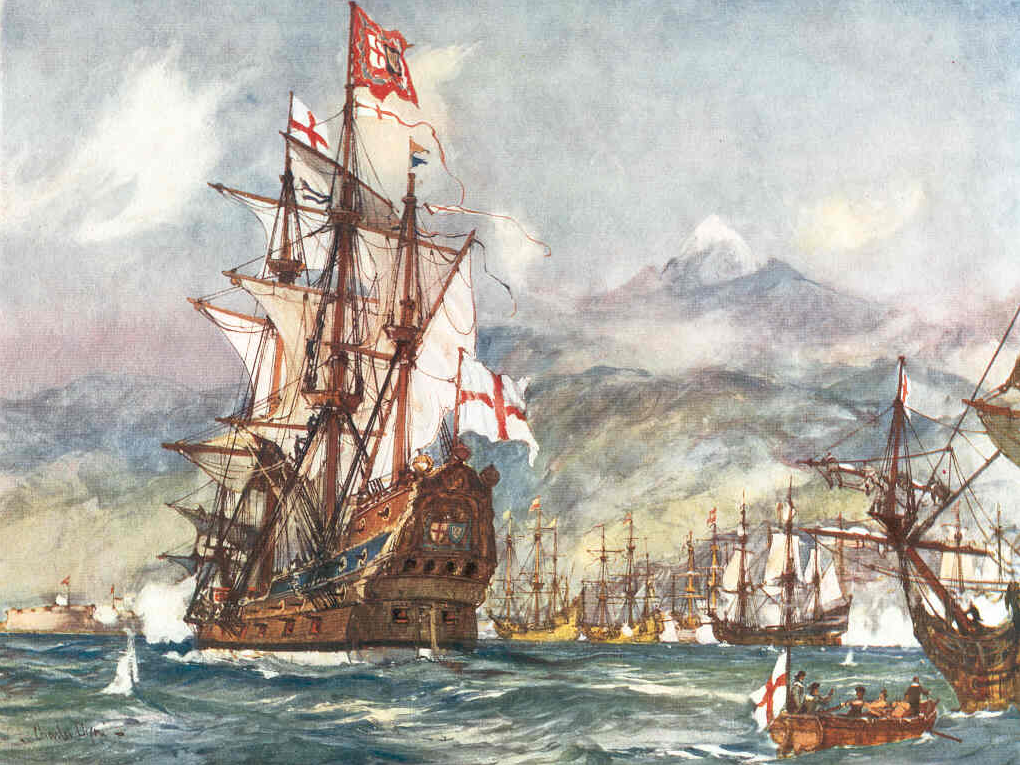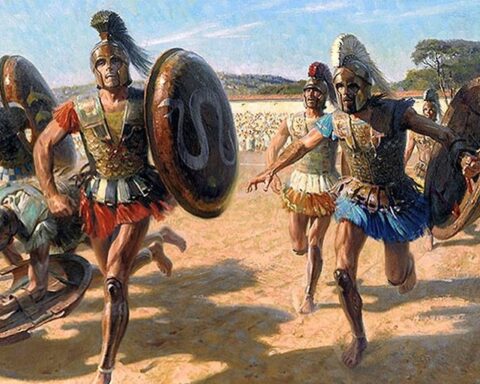Editor’s note: The following is extracted from A History of Sea Power, by William Oliver Stevens and Allan Westcott (published 1920). All spelling in the original.
(Continued from Part 1)
Porto Farina and Santa Cruz
Nor did the age of Blake end with the First Dutch War. As soon as the admiral was able to go aboard ship, Cromwell sent him with a squadron into the Mediterranean to enforce respect for the Commonwealth from the Italian governments and the Barbary states. He conducted his mission with eminent success. Although the Barbary pirates did not course the sea in great fleets as in the palmy days of Barbarossa, they were still a source of peril to Christian traders. Blake was received civilly by the Dey of Algiers but negotiations did not result satisfactorily. At Tunis he was openly flouted. The Pasha drew up his nine cruisers inside Porto Farina and defied the English admiral to do his worst. Blake left for a few days to gain the effect of surprise and replenish provisions. On April 4, 1655, he suddenly reappeared and stood in to the attack.
The harbor of Porto Farina was regarded as impregnable. The entrance was narrow and the shores lined with castles and batteries. As Blake foresaw, the wind that took him in would roll the battle smoke upon the enemy. In a short time he had silenced the fire of the forts and then sent boarding parties against the Tunisian ships, which were speedily taken and burnt. Then he took his squadron out again, having destroyed the entire Tunisian navy, shattered the forts, and suffered only a trifling loss. This exploit resounded throughout the Mediterranean. Algiers was quick to follow Tunis in yielding to Blake’s demands. It is characteristic of this officer that he should have made the attack on Tunis entirely without orders from Cromwell, and it is equally characteristic of the latter that he was heartily pleased with the initiative of his admiral in carrying out the spirit rather than the letter of his instructions.
Meanwhile Cromwell had been wavering between a war against France or Spain. The need of a capture of money perhaps influenced him to turn against Spain, for this country still drew from her western colonies a tribute of gold and silver, which naturally would fall a prey to the power that controlled the sea. One month after Blake’s exploit at Tunis, another English naval expedition set out to the West Indies to take Santo Domingo. Although Jamaica was seized and thereafter became an English possession, the expedition as a whole was a disgraceful failure, and the leaders, Penn and Venables, were promptly clapped by Cromwell into the Tower on their return. This stroke against Spain amounted to a declaration of war, and on Blake’s return to England he was ordered to blockade Cadiz. One detachment of the plate fleet fell into the hands of his blockading ships and the silver ingots were dispatched to London. Blake continued his blockade in an open roadstead for six months, through autumn and winter, an unheard of thing in those days and exceedingly difficult. Blake was himself ill, his ships were not the copper-bottomed ones of a hundred years later, and there was not, as in later days, an English base at Gibraltar. But he never relaxed his vigilance.
In April (1657) he learned that another large plate fleet had arrived at Santa Cruz, Teneriffe. Immediately he sailed thither to take or destroy it. If Porto Farina had been regarded as safe from naval attack, Santa Cruz was far more so. A deep harbor, with a narrow, funnel entrance, and backed by mountains, it is liable to dead calms or squally bursts of wind from the land. In addition to its natural defenses it was heavily fortified. Blake, however, reckoned on coming in with a flowing tide and a sea breeze that, as at Porto Farina, would blow his smoke upon the defenses. He rightly guessed that if he sailed close enough under the castles at the harbor entrance their guns could not be sufficiently depressed to hit his ships, and as he saw the galleons and their escorts lined up along the shore he perceived also that they were masking the fire of their own shore batteries. For the most difficult part of his undertaking, the exit from the harbor, he trusted to the ebbing tide with the chance of a shift in the wind in his favor.

Early on the morning of April 20th (1657) he sailed in. As he had judged, the fire of the forts did little damage. By eight o’clock the English ships were all at their appointed stations and fighting. During the entire day Blake continued his work of destruction till it was complete, and at dusk drifted out on the ebb. Some writers mention a favoring land breeze that helped to extricate the English, but according to Blake’s own words, “the wind blew right into the bay.” In spite of this head wind the ships that were crippled were warped or towed out and not one was lost. The English suffered in the entire action only 50 killed and 120 wounded, and repairs were so easily made that Blake returned to his blockading station at once.
This was the greatest of Blake’s feats as it also was his last. All who heard of it—friend or enemy—pronounced it as without parallel in the history of ships. A few months later Blake was given leave to return home. He had long been a sick man, but his name alone was worth a fleet and Cromwell had not been able to spare him. As it happened, he did not live long enough to see England again. Cromwell, who knew the worth of his faithful admiral, gave him a funeral of royal dignity and interment in Westminster Abbey.
Blake never showed, perhaps, great strategic insight—Tromp and de Ruyter were his superiors there, as was also Nelson—but he, more than any other, won for England her mastery of the sea, and no other can boast his record of great victories. These he won partly by skill and forethought but chiefly by intrepidity. We can do no better than leave his fame in the words of the Royalist historian, Clarendon—a political enemy—who says: “He quickly made himself signal there (on the sea) and was the first man who declined the old track … and disproved those rules that had long been in practice, to keep his ships and men out of danger, which had been held in former times a point of great ability and circumspection, as if the principal requisite in the captain of a ship had been to come home safe again. He was the first man who brought ships to contemn castles on shore, which had been thought ever very formidable…. He was the first that infused that proportion of courage into the seamen by making them see what mighty things they could do if they were resolved, and taught them to fight in fire as well as on water. And though he hath been very well imitated and followed, he was the first that drew the copy of naval courage and bold resolute achievement.”
The chaos that followed the death of the Protector resulted in Monk’s bringing over the exiled Stuart king, Charles II. Thereafter Round Head and Royalist served together in the British navy. An important effect of the Restoration was organization of a means of training the future officers of the fleet. The Navy as a profession may be said to date from this time, in contrast with the practice of using merchant skippers and army officers, which had prevailed to so great a degree hitherto. Under the new system “young gentlemen” were sent to sea as “King’s Letter Boys”—midshipmen—to learn the ways of the navy and to grow up in it as a preparation for command. This was an excellent reform but it resulted in making the navy the property of a social caste from that day to this, and it made promotion, for a century and more, largely subject to family influence.
Another effect of the Restoration was to break down the fighting efficiency of the fleet as it had been in the days of Blake. The veterans of the First Dutch War fought with their old time courage and discipline, but the newer elements did not show the same devotion and initiative. The effect on the material was still worse, for the fleet became a prey to the cynical dishonesty that Charles II inspired in every department of his government.









